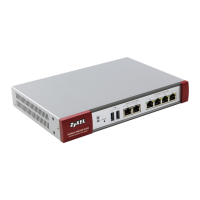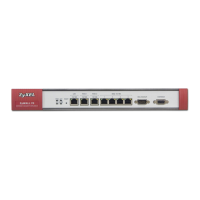Chapter 18 Inbound Load Balancing
USG20(W)-VPN Series User’s Guide
295
The following table describes the labels in this screen.
Table 118 Configuration > Network > Inbound LB > Add/Edit
LABEL DESCRIPTION
Create New Object Use this to configure any new setting objects that you need to use in this screen.
General Settings
Enable Select this to enable this DNS load balancing rule.
DNS Setting
Query Domain Name Type up to 255 characters for a domain name for which you want the USG to manage
DNS load balancing. You can use a wildcard (*) to let multiple domains match the
name. For example, use *.example.com to specify any domain name that ends with
“example.com” would match.
Time to Live Enter the number of seconds the USG recommends DNS request hosts to keep the
DNS entry in their caches before removing it. Enter 0 to have the USG not
recommend this so the DNS request hosts will follow their DNS server’s TTL setting.
Query From Setting
IP Address Enter the IP address of a computer or a DNS server which makes the DNS queries
upon which to apply this rule.
DNS servers process client queries using recursion or iteration:
• In recursion, DNS servers make recursive queries on behalf of clients. So you
have to configure this field to the DNS server’s IP address when recursion is
used.
• In iteration, a client asks the DNS server and expects the best and immediate
answer without the DNS server contacting other DNS servers. If the primary DNS
server cannot provide the best answer, the client makes iteration queries to other
configured DNS servers to resolve the name. You have to configure this field to
the client’s IP address when iteration is used.
Zone Select the zone of DNS query messages upon which to apply this rule.
Load Balancing
Member
Load Balancing
Algorithm
Select a load balancing method to use from the drop-down list box.
Select Weighted Round Robin to balance the traffic load between
interfaces based on their respective weights. An interface with a larger
weight gets more chances to transmit traffic than an interface with a
smaller weight. For example, if the weight ratio of wan1 and wan2
interfaces is 2:1, the USG chooses wan1 for 2 sessions’ traffic and wan2 for
every session’s traffic in each round of 3 new sessions.
Select Least Connection to have the USG choose the member interface which is
handling the least number of sessions.
Select Least Load - Outbound to have the USG choose the member interface which
is handling the least amount of outgoing traffic.
Select Least Load - Inbound to have the USG choose the member interface which
is handling the least amount of incoming traffic.
Select Least Load - Total to have the USG choose the member interface which is
handling the least amount of outgoing and incoming traffic.
Failover IP Address Enter an alternate IP address with which the USG will respond to a DNS query
message when the load balancing algorithm cannot find any available interface.
Add Click this to create a new member interface for this rule.
Edit Double-click an entry or select it and click Edit to open a screen where you can
modify the entry’s settings.

